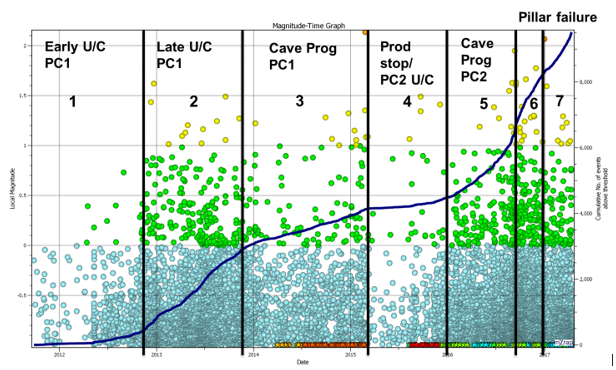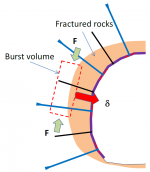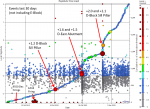7. Measurement and observation trends for forensic analysis: Difference between revisions
No edit summary |
No edit summary |
||
| (2 intermediate revisions by the same user not shown) | |||
| Line 1: | Line 1: | ||
__NOTOC__ | |||
[[File:2.07_Measurement_and_Observation_Trends.jpg| | [[File:2.07_Measurement_and_Observation_Trends.jpg|500px|left|link=]] | ||
<br clear=all> | |||
{| class="wikitable" | {| class="wikitable" | ||
|- | |- | ||
| | | | ||
|''' | |'''Standard Practices''' | ||
|'''Advanced Properties''' | |'''Advanced Properties''' | ||
|- | |- | ||
|7.1 Forensic analysis triggered by large events or rockbursts | |7.1 Forensic analysis triggered by large events or rockbursts | ||
[[File:Forensic analysis.png| | [[File:Forensic analysis.png|150px|link=]] | ||
(Cai and Kaiser 2018) | |||
|<li>Reporting incidents to meet regulatory requirements</li> | |<li>Reporting incidents to meet regulatory requirements</li> | ||
<li>Generic large event analysis without looking at broader implications and important learnings for systems improvement</li> | <li>Generic large event analysis without looking at broader implications and important learnings for systems improvement</li> | ||
| Line 17: | Line 21: | ||
|- | |- | ||
|7.2 Periodic reporting of trends | |7.2 Periodic reporting of trends | ||
[[File:Periodic reporting.png| | [[File:Periodic reporting.png|150px|link=]] | ||
|<li>Regular reporting of seismicity in the short, medium and long term</li> | |<li>Regular reporting of seismicity in the short, medium and long term</li> | ||
<li>Reporting | <li>Reporting standard event statistics, spatial plots and activity trends over time</li> | ||
|<li>Reporting of seismicity emphasises the understanding of how the rock mass responds to mining with respect to underlying sources and mechanisms of the rock mass deformation and failure</li> | |<li>Reporting of seismicity emphasises the understanding of how the rock mass responds to mining with respect to underlying sources and mechanisms of the rock mass deformation and failure</li> | ||
|} | |} | ||
| Line 35: | Line 39: | ||
== 7.1 Forensic analysis triggered by large events or rockbursts == | == 7.1 Forensic analysis triggered by large events or rockbursts == | ||
=== 7.1.1 | === 7.1.1 Standard === | ||
Most mining jurisdictions have requirements to report “near-miss” events and, more specifically, falls of ground, of which rockbursts are a sub-set. Very large seismic events are often recorded by regional or national seismic networks and may also attract the interest of regulators and the requirement for a report. The content of the regulatory reporting varies considerably from one mining district to another, but all mines have to comply with their own regulations, and as such are compelled to produce some form of forensic analysis. | Most mining jurisdictions have requirements to report “near-miss” events and, more specifically, falls of ground, of which rockbursts are a sub-set. Very large seismic events are often recorded by regional or national seismic networks and may also attract the interest of regulators and the requirement for a report. The content of the regulatory reporting varies considerably from one mining district to another, but all mines have to comply with their own regulations, and as such are compelled to produce some form of forensic analysis. | ||
In addition to satisfying regulatory reporting, | In addition to satisfying regulatory reporting, standard practices in a seismically-active mine would have a report, often a memorandum, containing a data summary and a superficial analysis of severe rockbursts and, in some cases, large seismic events with or without damage. | ||
=== 7.1.2 Advanced === | === 7.1.2 Advanced === | ||
The main difference between | The main difference between standard and advanced practices lies in the detail and depth of the forensic analyses performed. In particular, advanced practices would use both numerical modelling approaches described in Section 5, and several of the seismic source parameters analyses described in Section 6, as well as geological, mining and geotechnical data to construct an understanding of the large seismic event or rockburst. Individual case studies produced from the above forensic analyses are well documented and, over time, a good understanding of the seismic hazard and response to mining activities is developed. | ||
For mature mines, advanced practices have a comprehensive database of all these large events and rockbursts from which the data is easily searched, leading to the production of periodic compilations and analyses of trends described below. | For mature mines, advanced practices have a comprehensive database of all these large events and rockbursts from which the data is easily searched, leading to the production of periodic compilations and analyses of trends described below. | ||
== 7.2 Periodic reporting of trends == | == 7.2 Periodic reporting of trends == | ||
=== 7.2.1 | === 7.2.1 Standard === | ||
Most seismically-active mines have a daily report of the seismic activities which include, as a minimum, comments and/or statistics on the status of the seismic system, one or multiple plots of seismic activities of the last 24 hours, and any unusual trends or events worth reporting. | Most seismically-active mines have a daily report of the seismic activities which include, as a minimum, comments and/or statistics on the status of the seismic system, one or multiple plots of seismic activities of the last 24 hours, and any unusual trends or events worth reporting. | ||
The periods and content of the longer-term seismic reporting is quite variable from site-to-site, and once again, the | The periods and content of the longer-term seismic reporting is quite variable from site-to-site, and once again, the standard practices would include, as a minimum, statistics and comments on the status of the seismic system, one or multiple plots of the seismic activity recorded since the last period, and any unusual trends or events worth reporting. The “standard” periodic reports are widely distributed throughout the mining operation and some of the graphs are displayed in production areas. | ||
=== 7.2.2 Advanced === | === 7.2.2 Advanced === | ||
While the | While the standard practices on periodic reporting focus on documenting trends in the seismicity with minimal analyses, the advanced reporting practices will emphasise achieving a good understanding of the causes and the rock mass deformation and failure mechanisms of the sources of seismicity which are exhibiting elevated hazard during the period covered by the report. The link between the mining activities and changes in the seismic response of active seismic sources is scrutinised. Additionally, numerical modelling (Section 5) and seismic source parameter studies (Section 6) are relied upon to form part of the analysis. The magnitude-time graph shown in the figure below is a simple yet powerful tool to identify changes in the mine seismic behaviour. The advanced periodic reports are typically distributed to technical personnel and management. | ||
[[File:Figure 47.png | [[File:Figure 47.png|link=]] | ||
Figure: Magnitude-time graph underlining when changes in seismic behaviour occur | Figure: Magnitude-time graph underlining when changes in seismic behaviour occur | ||
Latest revision as of 15:00, 10 May 2019

| Standard Practices | Advanced Properties | |
| 7.1 Forensic analysis triggered by large events or rockbursts
(Cai and Kaiser 2018) |
||
| 7.2 Periodic reporting of trends
|
The measurements and observation of trends for forensic analysis is an essential step in the seismic management process that:
• identifies active sources of seismicity; • investigates how sources of seismicity respond to mining activities (e.g. blasting, production etc.); and • quantifies sources of seismicity in terms of time, location and magnitude.
Such analysis may be triggered by large events or rockbursts. Alternatively, the trends from the recorded seismic data are analysed and documented in periodic seismic reports (i.e. daily, weekly, monthly, quarterly, etc.).
It is noted that most of the measurements and data required for the forensic analyses are collected in some of the previous steps of the risk management process (i.e. the data collection; purple row).
7.1 Forensic analysis triggered by large events or rockbursts
7.1.1 Standard
Most mining jurisdictions have requirements to report “near-miss” events and, more specifically, falls of ground, of which rockbursts are a sub-set. Very large seismic events are often recorded by regional or national seismic networks and may also attract the interest of regulators and the requirement for a report. The content of the regulatory reporting varies considerably from one mining district to another, but all mines have to comply with their own regulations, and as such are compelled to produce some form of forensic analysis.
In addition to satisfying regulatory reporting, standard practices in a seismically-active mine would have a report, often a memorandum, containing a data summary and a superficial analysis of severe rockbursts and, in some cases, large seismic events with or without damage.
7.1.2 Advanced
The main difference between standard and advanced practices lies in the detail and depth of the forensic analyses performed. In particular, advanced practices would use both numerical modelling approaches described in Section 5, and several of the seismic source parameters analyses described in Section 6, as well as geological, mining and geotechnical data to construct an understanding of the large seismic event or rockburst. Individual case studies produced from the above forensic analyses are well documented and, over time, a good understanding of the seismic hazard and response to mining activities is developed. For mature mines, advanced practices have a comprehensive database of all these large events and rockbursts from which the data is easily searched, leading to the production of periodic compilations and analyses of trends described below.
7.2 Periodic reporting of trends
7.2.1 Standard
Most seismically-active mines have a daily report of the seismic activities which include, as a minimum, comments and/or statistics on the status of the seismic system, one or multiple plots of seismic activities of the last 24 hours, and any unusual trends or events worth reporting.
The periods and content of the longer-term seismic reporting is quite variable from site-to-site, and once again, the standard practices would include, as a minimum, statistics and comments on the status of the seismic system, one or multiple plots of the seismic activity recorded since the last period, and any unusual trends or events worth reporting. The “standard” periodic reports are widely distributed throughout the mining operation and some of the graphs are displayed in production areas.
7.2.2 Advanced
While the standard practices on periodic reporting focus on documenting trends in the seismicity with minimal analyses, the advanced reporting practices will emphasise achieving a good understanding of the causes and the rock mass deformation and failure mechanisms of the sources of seismicity which are exhibiting elevated hazard during the period covered by the report. The link between the mining activities and changes in the seismic response of active seismic sources is scrutinised. Additionally, numerical modelling (Section 5) and seismic source parameter studies (Section 6) are relied upon to form part of the analysis. The magnitude-time graph shown in the figure below is a simple yet powerful tool to identify changes in the mine seismic behaviour. The advanced periodic reports are typically distributed to technical personnel and management.

Figure: Magnitude-time graph underlining when changes in seismic behaviour occur



